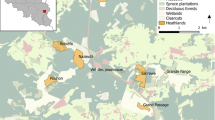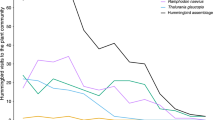Abstract
The influence of floral resource availability on behaviour and dominance hierarchy of hummingbirds has seldom been investigated in open tropical environments. We evaluated the behavioural changes of hummingbirds associated with Palicourea rigida, a shrub common in the Cerrado, the open savanna areas in Central Brazil. We observed the foraging behaviour as a function of resource availability and experimentally manipulated floral display and nectar in order to define resource thresholds associated with territorial behaviour and territory intruding behaviour. Territorial behaviour was observed only in patches with high floral abundance and was restricted to some hummingbird species. The large Eupetomena macroura seems to be the dominant species in the community, excluding other hummingbirds and holding the richest patches. The experimental reduction in the floral abundance and nectar led to the abandonment of territory by these hummingbirds, which reinforces the idea that a certain threshold is necessary to maintain territorial defence. Higher floral display, on the other hand, seems to lead to higher frequency of intrusions and higher behavioural complexity of territory defenders, possibly meaning greater energy expenditure. The flower number and nectar manipulation affected visitation rates of territorial hummingbirds, but the frequency of intruders was affected only by the former manipulation. This indicates that territorial intruder use visual cues (floral abundance) as indicators of resource availability in order to estimate cost–benefit of territory invasion. Although territorial behaviour could limit pollen flow in patches with larger floral displays, this may be compensated by the territory invaders, which bring pollen from other patches.
Zusammenfassung
Der Einfluss von Ressourcenverfügbarkeit von Blüten auf das Verhalten und die Dominanzhierarchie von Kolibris in offenen, tropischen Landschaften ist bisher nur selten untersucht worden. Wir erfassten Verhaltensveränderungen von Kolibris in Assoziation mit Palicourea rigida, einem häufiger Strauch in der Cerrado, der offenen Baumsavanne in Zentralbrasilien. Wir untersuchten das Foragierverhalten als eine Funktion der Ressourcenverfügbarkeit. Dazu manipulierten wir Blüten- und Nektarverfügbarkeit experimentell um Schwellenwerte von Ressourcenverfügbarkeit, assoziiert mit Territorialverhalten, zu schätzen. Territorialverhalten wurde nur an Stellen mit hoher Blütenabundanz beobachtet, und war beschränkt auf nur einige Kolibriarten. Der große Eupetomena macroura scheint die dominante Art in der Gemeinschaft zu sein: diese Art schloss andere Kolibriarten aus und besetzte die reichsten Stellen. Die experimentelle Verringerung von Blüten- und Nektarverfügbarkeit führte zum Verlassen von Territorien durch diese Kolibris, welches die Idee eines Schwellenwertes, für die Entstehung von Territorialverhalten unterstützt. Vermehrte Blütenverfügbarkeit jedoch führte scheinbar zu einer höheren Frequenz von Intrusions, und zu höherer Komplexität des Verhaltens des Verteidigers des Territoriums, was möglicherweise auf einen erhöhten Energieverbrauch hinweist. Die Blütenanzahl und die Nektarmanipulationen beeinflussten die Besuchsraten von territorialen Kolibris; die Frequenz der Eindringlinge jedoch wurde nur von der Blütenmanipulation beeinflusst. Dies suggeriert das die Eindringlinge visuelle Hinweise (Blütenabundanz) als Indikator für die Ressourcenverfügbarkeit verwenden, um die Kosten und den Nutzen einer Eindringung in ein Territorium abzuschätzen. Obwohl Territorialverhalten Pollenverbreitung limitieren kann, ist es möglich dass dieses durch die Eindringlinge kompensiert wird, welche Pollen von anderen Stellen mitbringen.




Similar content being viewed by others
References
Altshuler DL, Stiles FG, Dudley R (2004) Of hummingbirds and helicopters: hovering costs, competitive ability, and foraging strategies. Am Nat 163:16–25
Brody AK, Mitchell RJ (1997) Effects of experimental manipulation of inflorescence size on pollination and pre-dispersal seed predation in the hummingbird-pollinated plant Ipomopsis aggregata. Oecologia 110:86–93
Cotton PA (1998) Temporal partitioning of a floral resource by territorial hummingbirds. Ibis 140:647–653
Ewald PW, Carpenter FL (1978) Territorial responses to energy manipulations in the anna hummingbird. Oecologia 31:277–292
Feinsinger P (1978) Ecological interactions between plants and hummingbirds in a succecional tropical community. Ecol Monogr 48:269–287
Feinsinger P, Colwell RK (1978) Community organization among Neotropical nectar-feeding birds. Am Zool 18:779–795
Feinsinger P, Colwell RK, Terborgh J, Chaplin SB (1979) Elevation and the morphology, flight energetics, and foraging ecology of tropical hummingbirds. Am Nat 113:481–497
Ferreira ARJ, Smulders TV, Sameshima K, Mello CV, Jarvis ED (2006) Vocalizations and associated behaviors of the somber hummingbird (Aphantochroa cirrhochloris) and the rufous-breasted hermit (Glaucis hirsutus). Auk 123:1129–1148
Franceschinelli EV, Bawa KS (2000) The effect of ecological factors on the mating system of a South American shrub species (Helicteres brevispira). Heredity 84:116–123
Gottsberger G, Silberbauer-Gottsberger I (2006) Life in the Cerrado: a South American tropical seasonal ecosystem. Reta, Ulm
Grantsau R (1989) Os beija-flores do Brasil. Expressão e Cultura, Rio de Janeiro
Henderson J, Hurly TA, Bateson M, Healy SD (2006) Timing in free-living rufous hummingbirds, Selasphorus rufus. Curr Biol 16:512–515
Kodric-Brown A, Brown JH (1978) Influence of economics, interspecific competition, and sexual dimorphism on territoriality of migrant rufous hummingbirds. Ecology 59:285–296
Machado AO, Silva AP, Consolaro HN, Barros MG, Oliveira PE (2010) Breeding biology and distyly in Palicourea rigida H. B. & K. (Rubiaceae) in the Cerrados of Central Brazil. Acta Bot Bras 24(3):686–696. doi:10.1590/S0102-33062010000300012
Marchesseault L, Ewald PW (1991) Effect of territory quality on intrusion rate in nonbreeding hummingbirds. Behav Ecol Sociobiol 28:305–308
Ornelas JF, González C, Uribe J (2002) Complex vocalizations and aerial displays of the amethyst-throated hummingbird (Lampornis amethystinus). Auk 119:1141–1149
Ribeiro JF, Walter BMT (1998) Fitofisionomias do Bioma Cerrado. In: Sano SM, Almeida SP (eds) Cerrado: ambiente e flora. Embrapa, Planaltina, pp 89–166
Sazima I, Buzato S, Sazima M (1995) The saw-billed hermit Ramphodon naevius and its flowers in southeastern Brazil. J Ornithol 136:195–206
Sokal RR, Rohlf FJ (1981) Biometry, 2nd edn. Freeman, New York
Stiles FG, Wolf LL (1970) Hummingbird territoriality at a tropical flowering tree. Auk 87:467–491
Wolf LL, Hainsworth FR (1971) Time and energy budgets of territorial hummingbirds. Ecology 52:980–988
Acknowledgments
We thank C. Melo, S. Buzato, E. Tizo-Pedroso, H.N. Consolaro, A.O. Machado, P.A. Silva, K. Del-Claro, and I.E. Justino for their valuable help in many aspects of this study. The comments provided by B. Dalsgaard and the editors significantly improved the quality of the manuscript. We also thank the Clube Caça e Pesca Itororo de Uberlândia and the Agência Ambiental de Goiás for the use of their natural areas. Financial support was provided by CNPq (Conselho Nacional de Desenvolvimento Científico e Tecnológico) and FAPEMIG (Fundação de Amparo à Pesquisa do Estado de Minas Gerais) (CRA 0777/2008). We state that this study complies with the current laws of Brazil.
Author information
Authors and Affiliations
Corresponding author
Additional information
Communicated by J. Fjeldså.
Rights and permissions
About this article
Cite this article
Justino, D.G., Maruyama, P.K. & Oliveira, P.E. Floral resource availability and hummingbird territorial behaviour on a Neotropical savanna shrub. J Ornithol 153, 189–197 (2012). https://doi.org/10.1007/s10336-011-0726-x
Received:
Revised:
Accepted:
Published:
Issue Date:
DOI: https://doi.org/10.1007/s10336-011-0726-x




